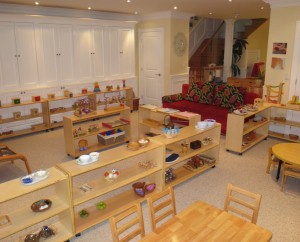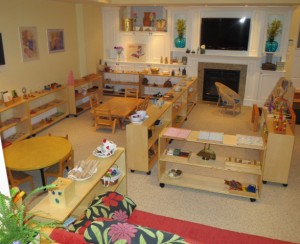Before elaborating any system of education, we must, therefore, create a favorable environment that will encourage the flowering of a child’s natural gifts. All that is needed is to remove the obstacles. And this should be the basis of, and point of departure for, all future education.
The first thing to be done, therefore, is to discover the true nature of a child and then assist him in his normal development.
Maria Montessori
The Secret of Childhood
Our image of children no longer considers them as isolated and egocentric, does not only see them as engaged in action with objects, does not emphasise only
the cognitive aspects, does not belittle feelings or what is not logical and does not consider with ambiguity the role of the reflective domain. Instead, our image of the child is rich in potential, strong, powerful, competent and, most of all, connected to adults and children.
Loris Malaguzzi
Founder of the Reggio Emilia Approach
Core Values
- Montessori’s view of the child as independent, intrinsically motivated, and actively learning
- The Reggio view of the child as learning within relationships and through creative expression
- A collaborative environment between teachers, children, and their families
- Teachers who are sensitive, well-trained, and life-long learners
- An environment prepared for the child that is safe, orderly, beautiful, and conservative of natural resources
- Respect for the similarities and differences in people, cultures, and ideas
Our Toddler Program is designed to meet the specific developmental needs of the 18 to 31-month-old child. The classroom is full of materials to support the toddler’s developing fine and gross motor skills, practical life skills, language and independence. It also provides ample opportunities to acquire and practice the skills needed to be a member of a community – primarily, respect for the environment, respect for self, and respect for others.
In the Toddler Program, children are provided with a supportive, nurturing environment in which their individual strengths and interests are allowed to develop and flourish. In doing this, we strive to encourage the children’s natural curiosity and set the foundations of a life-long love of learning.
We strive to build relationships and strengthen connections – between one child and another, between ourselves and the children in our care, between children and their families, between children and the natural world, and between ourselves and others who might look different, speak differently, or come from far away.
Daily we search for connections between the two strong educational traditions – that of Maria Montessori and her followers, and the educational philosophy developed by the early childhood programs in Reggio Emilia, Italy. We believe our study of these two philosophies has allowed us to use somewhat different vocabulary to describe similar phenomena. We believe that the process of viewing young children’s behavior from the different angles suggested by these approaches has enriched and deepened our understanding of what we see. We see ourselves as ongoing learners with the children and parents, so this study is stimulating and makes our work more interesting. Although Maria Montessori would not have advocated this, because the Montessori pedagogy is so well designed to carry children through an academic curriculum, we have noticed that it’s tempting to push children academically, and our study of Reggio reminds us not to do that.
These are the connections and relationships we have found between Montessori and Reggio:
Similarities:
-
- Respect for child paramount to process
- Similar view of the child – competent, capable, strong, offering a great deal to society
- Belief in child’s innate desire to learn and grow which compels them to explore, ask questions, listen, try things out, repeat activities, imitate behavior of adults they love
- Within both practices, teachers base what they do with children on careful observation of children and careful listening
- Children learn through interaction with a carefully designed environment
- Both approaches are constructivist in nature. (Children – humans – construct their understanding of the world through interaction with the environment, which includes people. Children are not empty vessels which can be filled with knowledge)
Areas from which Montessori teachers can draw inspiration from the Reggio philosophy:
- Emergent curriculum vs. highly developed integrated curriculum
- Working with small groups of children
- Embracing ideas from social constructivism – building social skills; learning from each other;
- Adding careful listening to our careful observation
- Montessori – didactic materials with specific purpose
- Idea of many languages which children use to grow and express understanding
- Strong emphasis on school community and close work with families
- Strong emphasis on the culture of a school community – knowing strengths, values, hopes and dreams, activities. That is the context from which our children emerge.
- Using documentation to enhance our program
- Beauty and celebration of art within our orderly, functional Montessori environments
Montessori
 Dr. Maria Montessori began her work with children in the early 1900s. She was the first woman to receive a medical degree in Italy and with her medical background began working with pediatric psychiatric patients in Rome. Through careful observation of those children, she began to develop an approach to working with preschool aged children that was revolutionary in her day. After achieving success with children previously thought uneducable, she began working with normal preschool aged children, and began to develop an approach to education and a body of didactic materials which are used in Montessori schools today. Hallmarks of the Montessori method of education are:
Dr. Maria Montessori began her work with children in the early 1900s. She was the first woman to receive a medical degree in Italy and with her medical background began working with pediatric psychiatric patients in Rome. Through careful observation of those children, she began to develop an approach to working with preschool aged children that was revolutionary in her day. After achieving success with children previously thought uneducable, she began working with normal preschool aged children, and began to develop an approach to education and a body of didactic materials which are used in Montessori schools today. Hallmarks of the Montessori method of education are:
- respect for each child’s individual path through recognized developmental stages of growth
- the necessity of freely chosen activity within a prepared environment
- close observation of children
- a profound belief in the intrinsic human satisfaction in learning and growing which makes education reward enough, eliminating the need for external rewards related to achievement
She observed that younger children learned from older ones, who in turn derived pleasure and solidified their understandings by being a helper to younger ones, and thus grouped children in mixed age groups. In her schools the role of the adult, or teacher, became a guide to children, responsible for preparing and maintaining a rich, child sized environment, and for providing a link between the environment and the child in the form of carefully practiced lessons with the materials in the classroom. The Montessori teacher is available to provide needed help, and to establish and maintain appropriate emotional and social limits and guidelines.
Reggio Emilia
Montessori and Reggio Emilia
 The Reggio Emilia educational philosophy comes from the city of Reggio Emilia in the northern Italy. Reggio Emilia was heavily damaged during World War II, leaving families concerned about the education of their young children. After the war, parents of the city sold a few horses and tanks left behind by Germans forces, and began to build a school for their children. They were joined by educator Loris Mallaguzzi, and together they began to develop schools they hoped would educate children who were so secure, so intellectually and emotionally strong, and so connected with society, that never again could a Hitler rise to power in the world.
The Reggio Emilia educational philosophy comes from the city of Reggio Emilia in the northern Italy. Reggio Emilia was heavily damaged during World War II, leaving families concerned about the education of their young children. After the war, parents of the city sold a few horses and tanks left behind by Germans forces, and began to build a school for their children. They were joined by educator Loris Mallaguzzi, and together they began to develop schools they hoped would educate children who were so secure, so intellectually and emotionally strong, and so connected with society, that never again could a Hitler rise to power in the world.
Mallaguzzi believed that children used “a hundred languages” to construct their understanding of the world – they talked, wrote, painted, danced, sang, hopped, drew, laughed, sculpted, imagined as they explored their world. For those of us who have made it a career to observe young children, the notion that they use all their diverse powers to make sense of the world is easy to accept. We see it every day. In 1991, Newsweek called the schools in Reggio Emilia among the best preschools in the world.
The Montessori and Reggio educational approaches share some common beliefs, one being that a prepared environment is so important to young children that it can be considered another teacher. They share a similar view of children as being capable of initiating and managing much of their own learning by freely choosing activities within a carefully prepared environment. There are some profound differences in the two philosophies, however, which opens the possibility for learning, and that teachers schooled in each approach might learn from each other’s ideas. In our toddler room, we have chosen to incorporate some ideas from Reggio Emilia into our strong Montessori program.
The Hundred Languages of Children Illuminated Poem
